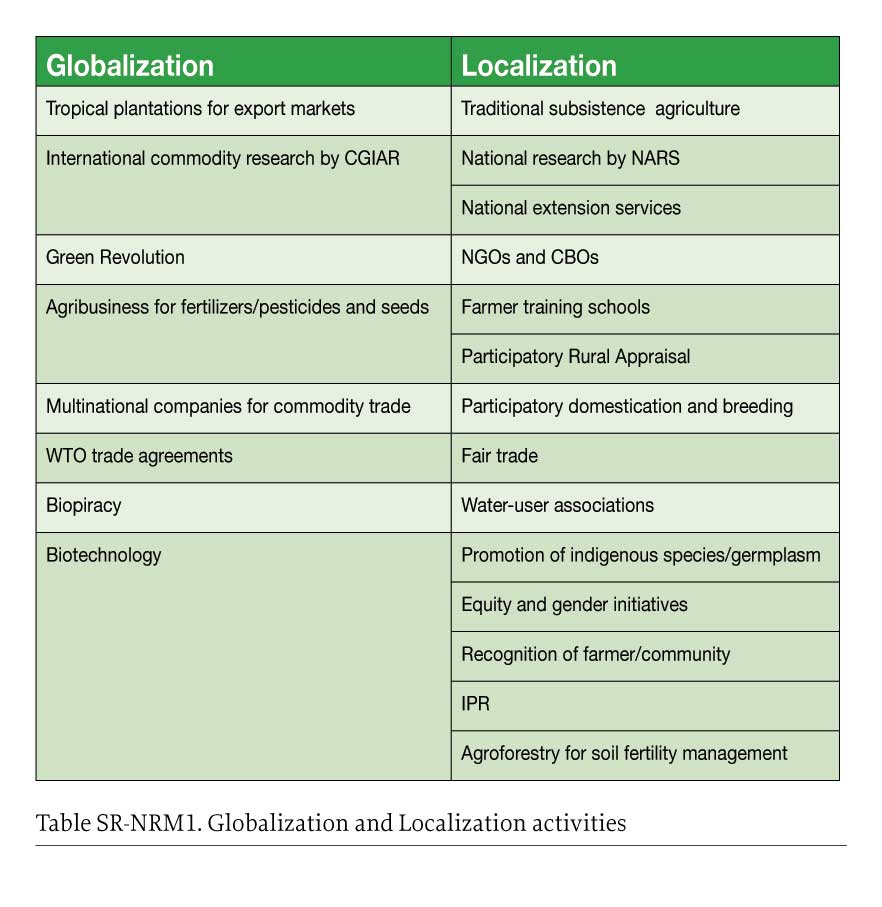ing or removing policies that constraint these partnerships [LAC Chapter 4; NAE Chapter 6].
Connect globalization and localization pathways that link locally generated NRM knowledge and innovations to public and private AKST to achieve more equitable and sustainable rural development.
Since the mid-20th century, globalization has been a dominant force in formal AKST. Public sector agriculture research, international trade and marketing, and international policy have been influential forces shaping globalization. Localization initiatives (Global Chapter 3; NAE Chapter 6) have come from the grassroots of civil society and involve locally based innovations that meet local needs of people and communities. Some current initiatives are drawing the two pathways together in ways that promote local-global partnerships for expanded economic opportunities. This is particularly true in the developing world in relation to the sustainable use of natural resources in agriculture [Global Chapter 3; NAE Chapter 6]. Natural resource management initiatives that illustrate how to bring localization and globalization together include:
• Promotion of customary foods to meet the needs and priorities of local people for self sufficiency, nutritional and food security, income generation and employment [Global Chapter 3].
• Domestication and commercialization of indigenous food-related plants and animal species [Global Chapter 3].
Global initiatives for sustainable development have brought attention to NRM issues at local and global levels, and have been effective in triggering the formation of civil society organizations, thereby stimulating new linkages with regional and/or global partners. Since the onset of the millennium some of these include: The Cartagena Protocol on Biosafety |
|
to the Convention on Biological Diversity (Montreal, Canada) in 2001, the International Treaty on Plant Genetic Resources for Food and Agriculture (Rome, Italy) in 2001, the World Summit on Sustainable Development (Johannesburg, South Africa) in 2002, and the World Food Summit (Rome, Italy) in 2002. Similarly, several international and regional assessments of relevance to NRM have promoted sustainable practices and people-oriented policies for addressing these issues. Some of these include: Millennium Ecosystem Assessment (2005); Intergovernmental Panel on Climate Change (1990, 1992, 1994, 2001, 2006); Comprehensive Assessment of Water in Agriculture (2007); Global Environmental Outlook; European Union Water Initiative; and European Union Soil Initiative.
Ways forward
Natural resource management is central to agricultural production and productivity, maintenance of critical ecosystem services and sustainable rural livelihoods. Agriculture represents one important management option, which when carried out in harmony with the landscape, can be beneficial to a wide range of stakeholders at all levels of community development [NAE-SDM]. It is evident that the severity of uncontrolled exploitation of natural capital is having major negative impacts on the livelihoods of both rural and urban people. By drawing down so severely on natural capital, rather than living on the interest, we are jeopardizing future generations. The challenges can be resolved if AKST is used and developed creatively with active participation among various stakeholders across multiple scales. This must be done in order to reverse the misuse of natural capital and ensure the judicious use and renewal of water bodies, soils, biodiversity, ecosystems services, fossil fuels and atmospheric quality for future generations. |
